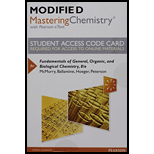
(a)
Interpretation:
The given set of elements has to be arranged in increasing order of atomic radius.
Concept Introduction:
The atomic radius of a chemical element is a measure of the size of its atoms, the atomic radius is distance from the centre of the nucleus to the boundary of the surrounding cloud of electrons.
The atomic radius decreases from left side to right side in the periodic table whereas atomic radius increases from top to bottom in the periodic table.
(b)
Interpretation:
The increasing atomic radius of the element should be identified.
Concept introduction:
The atomic radius of a chemical element is a measure of the size of its atoms, the atomic radius is distance from the center of the nucleus to the boundary of the surrounding cloud of electrons.
The atomic radius decreases from left side to right side in the periodic table whereas atomic radius increases from top to bottom in the periodic table.
(c)
Interpretation:
The increasing atomic radius of the element should be identified.
Concept Introduction:
The atomic radius of a chemical element is a measure of the size of its atoms, the atomic radius is distance from the center of the nucleus to the boundary of the surrounding cloud of electrons.
The atomic radius decreases from left side to right side in the periodic table whereas atomic radius increases from top to bottom in the periodic table.
Want to see the full answer?
Check out a sample textbook solution
Chapter 2 Solutions
Modified Mastering Chemistry With Pearson Etext -- Standalone Access Card -- For Fundamentals Of General, Organic, And Biological Chemistry (8th Edition)
- What enables a radioisotope to substitute for an ordinary (nonradioactive) atom of the same element molecule?arrow_forwardThe triple point of an element is at 75 torr and 125°C. This means that liquid is more dense than solid cannot exist at 1 atmosphere pressure cannot have a vapor pressure less than 75 torr cannot exist above 125 degrees Celsius What is the electron geometry (or electron arrangement) around an atom in a molecule or ion which is surrounded by three lone pairs of electrons and two single bonds T-shaped see-saw trigonal planar trigonal bipyramidal linear A red blood cell placed in pure water will swell because water moves from a higer osmotic pressure to a lower osmotic pressure the osmotic pressure is greater in the cell than in the water the osmotic pressure is the same in the cell and the water the somotic pressure is greater in the water than in the cellarrow_forwardWhich of the following substances will have the greatest lattice energy? MgS NaF MgO CaOarrow_forward
- The atomic mass number of an atom is determined by the sum of the number of in the atom. (a) protons plus electrons plus neutrons (b) protons plus electrons (c) neutrons plus electrons (d) neutrons plus protonsarrow_forwardArrange the elements Na, Si, and S in the order of(a) decreasing atomic radius.(h)increasing first ionization energy.arrow_forwardwhat subatomic particle is present in the nucleus of an atom?arrow_forward
- How does the atomic structure or composition of the versions of sodium in question C above differ from a typical sodium atom, with its atomic mass of 23?arrow_forwardWhich of the following items are pure elements—that is, made up of only one type of atom? Check all that apply. A. Iron B. Cake C. Carbonarrow_forwardif 10 magnesium atoms and 10 chlorine atoms were allowed to bump into each other, could they combine to form a substance? How many molecules made? Would there be any atoms left over? Which ones? How many?arrow_forward
- Which of the following levels in the shell model of an atom can hold up to two electrons? A. The second shell B. The first shell C. The third shellarrow_forwardHow many protons, electrons, and neutrons are present in the following ? Magnesium cation (Mg2+), Chloride anion (Cl-), Carbon -14(14C), and Tritium (3H)?arrow_forwardExplain the boiling point of a compound ?arrow_forward

 Biology (MindTap Course List)BiologyISBN:9781337392938Author:Eldra Solomon, Charles Martin, Diana W. Martin, Linda R. BergPublisher:Cengage Learning
Biology (MindTap Course List)BiologyISBN:9781337392938Author:Eldra Solomon, Charles Martin, Diana W. Martin, Linda R. BergPublisher:Cengage Learning Principles Of Radiographic Imaging: An Art And A ...Health & NutritionISBN:9781337711067Author:Richard R. Carlton, Arlene M. Adler, Vesna BalacPublisher:Cengage Learning
Principles Of Radiographic Imaging: An Art And A ...Health & NutritionISBN:9781337711067Author:Richard R. Carlton, Arlene M. Adler, Vesna BalacPublisher:Cengage Learning




